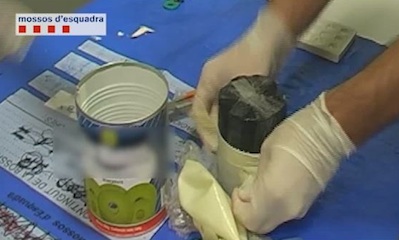Mexico’s drug traffickers appear to be looking to expand the methamphetamine trade far beyond the Western Hemisphere, as evidenced by what may be Spain’s biggest ever meth seizure — which was reportedly destined for the highly lucrative Australian market.
Police in Barcelona found 131 kilos of meth hidden in 18,000 pineapple cans, worth an estimated $37 million, reported Spanish newspaper El Pais. They traced the shipment after four of the pineapple cans ended up in the hands of a local businessman, who wanted to examine the goods to see if they were worth buying, and instead ended up notifying the police about the hidden drugs. Spanish authorities also detained two Mexican nationals in the operation, reported EFE.
SEE ALSO: Coverage of European Organized Crime
The meth reportedly originated from Jalisco, Mexico, and was meant to be sent on to Australia, according to Milenio.
According to data from the United Nations Office on Drugs and Crime (UNODC), this is the largest seizure of methamphetamines ever made in Spain, as well as in much of mainland Europe (although the UN data doesn’t yet include seizure statistics from 2013). Meth shipments of a comparable size have been seized in the Nordic countries, including Norway and Sweden.
InSight Crime Analysis
This seizure indicates that there is some enterprising meth-trafficking organization based in Mexico that rightly sees a giant market opportunity in Australia. According to the UNODC, the average wholesale price for a kilo of methamphetamine in Australia is about nineteen times that in Mexico, and about ten times that in Spain, as the chart below illustrates. This means huge potential profits for organized crime.
Australian authorities have identified growing meth consumption as a serious problem. The Australian Crime Commission’s most recent report compared the country’s crystal meth market to the crack cocaine “pandemic” in the United States in the 1980s. The country seized a record amount of amphetamine-type stimulants (ATS) at its borders between 2012 and 2013, much of which consisted of crystal and liquid meth.
Additionally, the most recent survey by Australia’s National Drug and Alcohol Research Centre found that intravenous injection of methamphetamine had grown nine percent over the past decade, with 61 percent of intravenous drug users stating that they had used meth in the past six months. And based on sampling by authorities, the average purity of meth in Australia is currently at the highest it’s been in the past decade.
While there is some local methamphetamine production in Australia, mostly in small labs, the drug is also trafficked into the country from China and Thailand.
For Mexico’s meth producers, Australia is a prime locale to expand their business. One candidate in this regard would be the Sinaloa Cartel, with previous reports indicating this criminal federation is already making serious headway in the country’s cocaine market.
SEE ALSO: Sinaloa Cartel News and Profile
Another Mexican drug trafficking organization that could have coordinated Spain’s record meth seizure is the Jalisco Cartel – New Generation (know as the CJNG by its initials in Spanish), which has a strong presence in Jalisco state. Jalisco is a hub for the methamphetamine trade — the Mexican Army seized a record 15 tons of the drug there in 2012.
One noteworthy thing about this meth shipment is that while there have been reports of Mexico-based groups increasingly getting involved in Europe’s drug trade, until now they have had a smaller share in the market than some of their counterparts in Latin America and the Caribbean. Data kept by the UNODC shows that Spanish authorities have seized far more drug shipments that departed from Venezuela, Colombia, and to a lesser extent the Dominican Republic than those that departed from Mexico.
For this reason, it is also curious that whatever criminal group is behind the record meth seizure chose to send the shipment from Mexico to Australia via Spain, rather than directly trafficking it from Mexico’s Pacific coast — for example, from the country’s biggest port, Lazaro Cardenas.
In any case, the seizure should certainly ring alarm bells for authorities in both Europe and Australia. Australia may be half a world away from Mexico, but the profits there may be far too attractive for Mexican organized crime to ignore.

